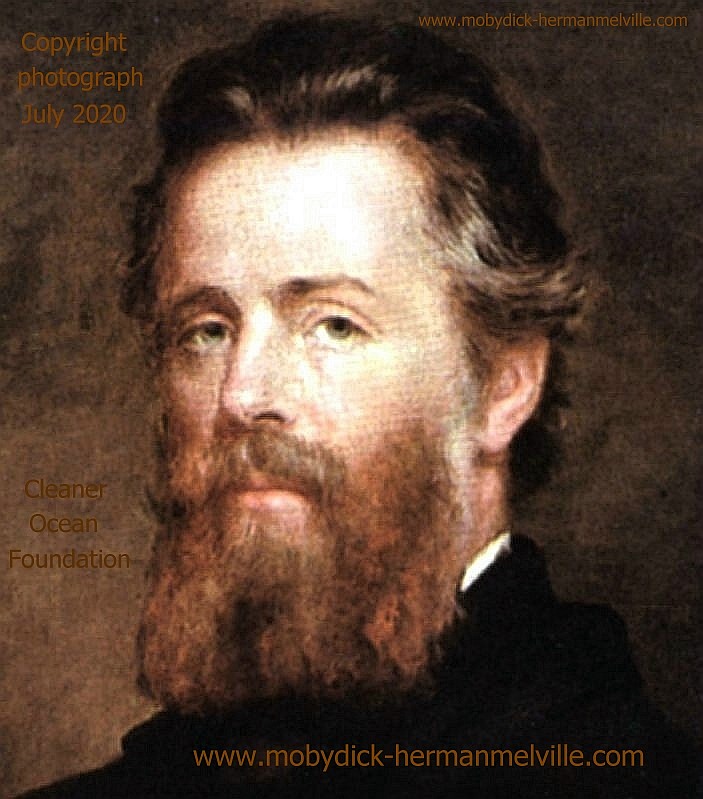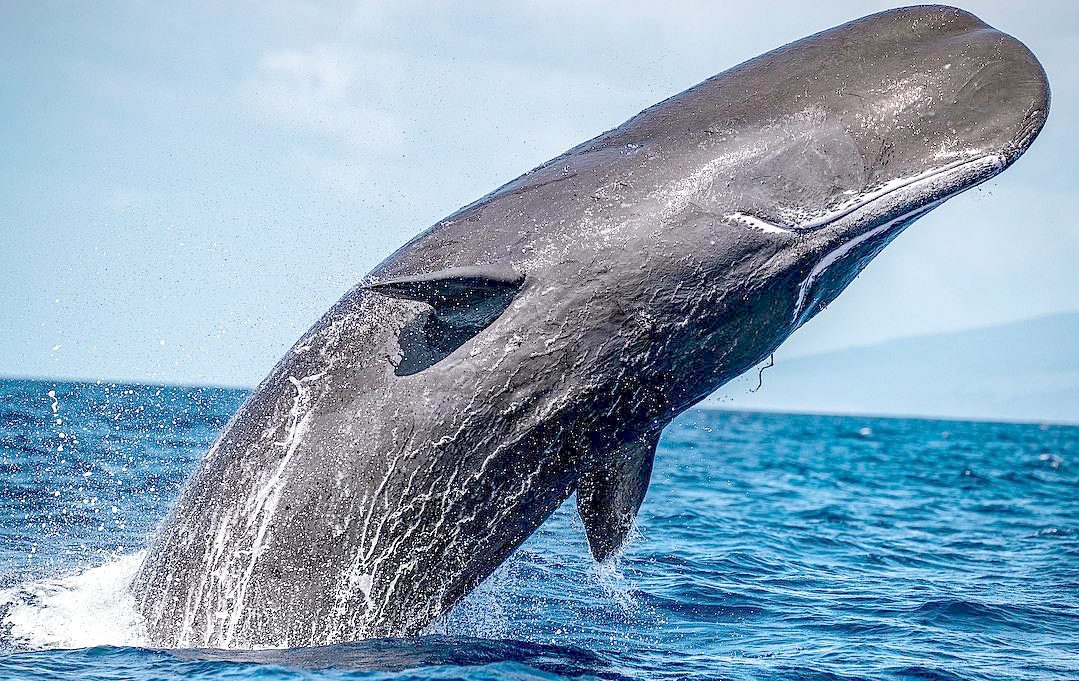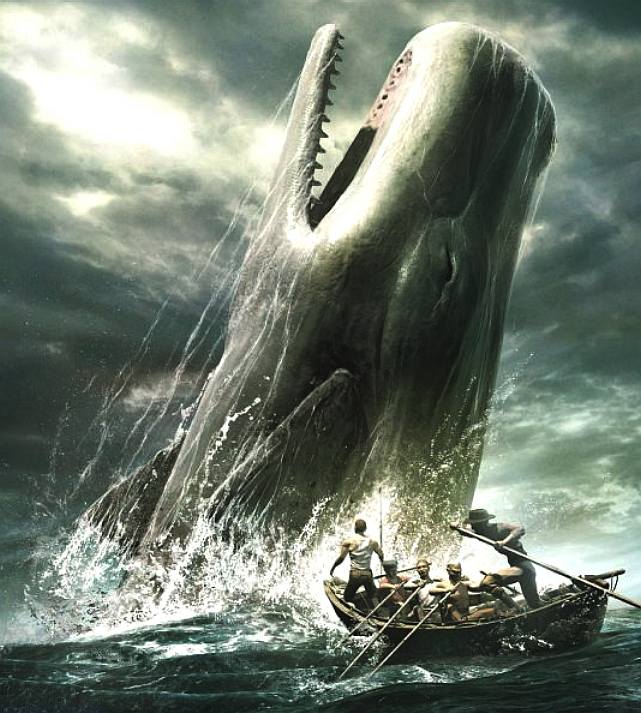
Herman
Melville was the author of a story about what we'd now consider an illegal activity,
the commercial hunting of whales for oil and meat. Whaling is still
carried out by Japan, Iceland and Canada, among other nations, though
most nations voluntarily abstain in the interests of conserving these
magnificent animals - as per International
Whaling Commission guidelines.
Back <<<
CHAPTER 56. Of the Less Erroneous Pictures of Whales, and the True
Pictures of Whaling Scenes.
In connexion with the monstrous pictures of whales, I am strongly tempted here to enter upon those still more monstrous stories of them which are to be found in certain books, both ancient and modern, especially in Pliny, Purchas, Hackluyt, Harris, Cuvier, etc. But I pass that matter by.
I know of only four published outlines of the great Sperm Whale; Colnett's, Huggins's, Frederick Cuvier's, and Beale's. In the previous chapter Colnett and Cuvier have been referred to. Huggins's is far better than theirs; but, by great odds, Beale's is the best. All Beale's drawings of this whale are good, excepting the middle figure in the picture of three whales in various attitudes, capping his second chapter. His frontispiece, boats attacking Sperm Whales, though no doubt calculated to excite the civil scepticism of some parlor men, is admirably correct and life-like in its general effect. Some of the Sperm Whale drawings in J. Ross Browne are pretty correct in contour; but they are wretchedly engraved. That is not his fault though.
Of the Right Whale, the best outline pictures are in Scoresby; but they are drawn on too small a scale to convey a desirable impression. He has but one picture of whaling scenes, and this is a sad deficiency, because it is by such pictures only, when at all well done, that you can derive anything like a truthful idea of the living whale as seen by his living hunters.
But, taken for all in all, by far the finest, though in some details not the most correct, presentations of whales and whaling scenes to be anywhere found, are two large French engravings, well executed, and taken from paintings by one Garnery. Respectively, they represent attacks on the Sperm and Right Whale. In the first engraving a noble Sperm Whale is depicted in full majesty of might, just risen beneath the boat from the profundities of the ocean, and bearing high in the air upon his back the terrific wreck of the stoven planks. The prow of the boat is partially unbroken, and is drawn just balancing upon the monster's spine; and standing in that prow, for that one single incomputable flash of time, you behold an oarsman, half shrouded by the incensed boiling spout of the whale, and in the act of leaping, as if from a precipice. The action of the whole thing is wonderfully good and true. The half-emptied line-tub floats on the whitened sea; the wooden poles of the spilled harpoons obliquely bob in it; the heads of the swimming crew are scattered about the whale in contrasting expressions of affright; while in the black stormy distance the ship is bearing down upon the scene. Serious fault might be found with the anatomical details of this whale, but let that pass; since, for the life of me, I could not draw so good a one.
In the second engraving, the boat is in the act of drawing alongside the barnacled flank of a large running Right Whale, that rolls his black weedy bulk in the sea like some mossy rock-slide from the Patagonian cliffs. His jets are erect, full, and black like soot; so that from so abounding a smoke in the chimney, you would think there must be a brave supper cooking in the great bowels below. Sea fowls are pecking at the small crabs, shell-fish, and other sea candies and maccaroni, which the Right Whale sometimes carries on his pestilent back. And all the while the thick-lipped leviathan is rushing through the deep, leaving tons of tumultuous white curds in his wake, and causing the slight boat to rock in the swells like a skiff caught nigh the paddle-wheels of an ocean steamer. Thus, the foreground is all raging commotion; but behind, in admirable artistic contrast, is the glassy level of a sea becalmed, the drooping unstarched sails of the powerless ship, and the inert mass of a dead whale, a conquered fortress, with the flag of capture lazily hanging from the whale-pole inserted into his spout-hole.
Who Garnery the painter is, or was, I know not. But my life for it he was either practically conversant with his subject, or else marvellously tutored by some experienced whaleman. The French are the lads for painting action. Go and gaze upon all the paintings of Europe, and where will you find such a gallery of living and breathing commotion on canvas, as in that triumphal hall at Versailles; where the beholder fights his way, pell-mell, through the consecutive great battles of France; where every sword seems a flash of the Northern Lights, and the successive armed kings and Emperors dash by, like a charge of crowned centaurs? Not wholly unworthy of a place in that gallery, are these sea battle-pieces of Garnery.
The natural aptitude of the French for seizing the picturesqueness of things seems to be peculiarly evinced in what paintings and engravings they have of their whaling scenes. With not one tenth of England's experience in the fishery, and not the thousandth part of that of the Americans, they have nevertheless furnished both nations with the only finished sketches at all capable of conveying the real spirit of the whale hunt. For the most part, the English and American whale draughtsmen seem entirely content with presenting the mechanical outline of things, such as the vacant profile of the whale; which, so far as picturesqueness of effect is concerned, is about tantamount to sketching the profile of a pyramid. Even Scoresby, the justly renowned Right whaleman, after giving us a stiff full length of the Greenland whale, and three or four delicate miniatures of narwhales and porpoises, treats us to a series of classical engravings of boat hooks, chopping knives, and grapnels; and with the microscopic diligence of a Leuwenhoeck submits to the inspection of a shivering world ninety-six fac-similes of magnified Arctic snow crystals. I mean no disparagement to the excellent voyager (I honour him for a veteran), but in so important a matter it was certainly an oversight not to have procured for every crystal a sworn affidavit taken before a Greenland Justice of the Peace.
In addition to those fine engravings from Garnery, there are two other French engravings worthy of note, by some one who subscribes himself "H. Durand." One of them, though not precisely adapted to our present purpose, nevertheless deserves mention on other accounts. It is a quiet noon-scene among the isles of the Pacific; a French whaler anchored, inshore, in a calm, and lazily taking water on board; the loosened sails of the ship, and the long leaves of the palms in the background, both drooping together in the breezeless air. The effect is very fine, when considered with reference to its presenting the hardy fishermen under one of their few aspects of oriental repose. The other engraving is quite a different affair: the ship hove-to upon the open sea, and in the very heart of the Leviathanic life, with a Right Whale alongside; the vessel (in the act of cutting-in) hove over to the monster as if to a quay; and a boat, hurriedly pushing off from this scene of activity, is about giving chase to whales in the distance. The harpoons and lances lie levelled for use; three oarsmen are just setting the mast in its hole; while from a sudden roll of the sea, the little craft stands half-erect out of the water, like a rearing horse. From the ship, the smoke of the torments of the boiling whale is going up like the smoke over a village of smithies; and to windward, a black cloud, rising up with earnest of squalls and rains, seems to quicken the activity of the excited seamen.
Next
>>>

BOOK
CHAPTERS
CHAPTER 1. Loomings.
CHAPTER
2. The Carpet-Bag.
CHAPTER
3. The Spouter-Inn.
CHAPTER
4. The Counterpane.
CHAPTER
5. Breakfast.
CHAPTER
6. The Street.
CHAPTER
7. The Chapel.
CHAPTER
8. The Pulpit.
CHAPTER
9. The Sermon.
CHAPTER
10. A Bosom Friend.
CHAPTER
11. Nightgown.
CHAPTER
12. Biographical.
CHAPTER
13. Wheelbarrow.
CHAPTER
14. Nantucket.
CHAPTER
15. Chowder.
CHAPTER
16. The Ship.
CHAPTER
17. The Ramadan.
CHAPTER
18. His Mark.
CHAPTER
19. The Prophet.
CHAPTER
20. All Astir.
CHAPTER
21. Going Aboard.
CHAPTER
22. Merry Christmas.
CHAPTER
23. The Lee Shore.
CHAPTER
24. The Advocate.
CHAPTER
25. Postscript.
CHAPTER
26. Knights and Squires.
CHAPTER
27. Knights and Squires.
CHAPTER
28. Ahab, Captain.
CHAPTER
29. Enter Ahab; to Him, Stubb.
CHAPTER
30. The Pipe.
CHAPTER
31. Queen Mab.
CHAPTER
32. Cetology.
CHAPTER
33. The Specksnyder.
CHAPTER
34. The Cabin-Table.
CHAPTER
35. The Mast-Head.
CHAPTER
36. The Quarter-Deck.
CHAPTER
37. Sunset.
CHAPTER
38. Dusk.
CHAPTER
39. First Night Watch.
CHAPTER
40. Midnight, Forecastle.
CHAPTER
41. Moby Dick.
CHAPTER
42. The Whiteness of The Whale.
CHAPTER
43. Hark!
CHAPTER
44. The Chart.
CHAPTER
45. The Affidavit.
CHAPTER
46. Surmises.
CHAPTER
47. The Mat-Maker.
CHAPTER
48. The First Lowering.
CHAPTER
49. The Hyena.
CHAPTER
50. Ahab's Boat and Crew. Fedallah.
CHAPTER
51. The Spirit-Spout.
CHAPTER
52. The Albatross.
CHAPTER
53. The Gam.
CHAPTER
54. The Town-Ho's Story.
CHAPTER
55. Of the Monstrous Pictures of Whales.
CHAPTER
56. Of the Less Erroneous Pictures of Whales, and the True
CHAPTER
57. Of Whales in Paint; in Teeth; in Wood; in Sheet-Iron; in
CHAPTER
58. Brit.
CHAPTER
59. Squid.
CHAPTER
60. The Line.
CHAPTER
61. Stubb Kills a Whale.
CHAPTER
62. The Dart.
CHAPTER
63. The Crotch.
CHAPTER
64. Stubb's Supper.
CHAPTER
65. The Whale as a Dish.
CHAPTER
66. The Shark Massacre.
CHAPTER
67. Cutting In
CHAPTER
69. The Funeral.
CHAPTER
70. The Sphynx.
CHAPTER
71. The Jeroboam's Story.
CHAPTER
72. The Monkey-Rope.
CHAPTER
73. Stubb and Flask Kill a Right Whale; and Then Have a Talk
CHAPTER
74. The Sperm Whale's Head—Contrasted View.
CHAPTER
75. The Right Whale's Head—Contrasted View.
CHAPTER
76. The Battering-Ram.
CHAPTER
77. The Great Heidelburgh Tun.
CHAPTER
78. Cistern and Buckets.
CHAPTER
79. The Prairie.
CHAPTER
80. The Nut.
CHAPTER
81. The Pequod Meets The Virgin.
CHAPTER
82. The Honour and Glory of Whaling.
CHAPTER
83. Jonah Historically Regarded.
CHAPTER
84. Pitchpoling.
CHAPTER
85. The Fountain.
CHAPTER
86. The Tail.
CHAPTER
87. The Grand Armada.
CHAPTER
88. Schools and Schoolmasters.
CHAPTER
89. Fast-Fish and Loose-Fish.
CHAPTER
90. Heads or Tails.
CHAPTER
91. The Pequod Meets The Rose-Bud.
CHAPTER
92. Ambergris.
CHAPTER
93. The Castaway.
CHAPTER
94. A Squeeze of the Hand.
CHAPTER
95. The Cassock.
CHAPTER
96. The Try-Works.
CHAPTER
97. The Lamp.
CHAPTER
98. Stowing Down and Clearing Up.
CHAPTER
99. The Doubloon.
CHAPTER
100. Leg and Arm.
CHAPTER
101. The Decanter.
CHAPTER
102. A Bower in the Arsacides.
CHAPTER
103. Measurement of The Whale's Skeleton.
CHAPTER
104. The Fossil Whale.
CHAPTER
105. Does the Whale's Magnitude Diminish?—Will He Perish?
CHAPTER
106. Ahab's Leg.
CHAPTER
107. The Carpenter.
CHAPTER
108. Ahab and the Carpenter.
CHAPTER
109. Ahab and Starbuck in the Cabin.
CHAPTER
110. Queequeg in His Coffin.
CHAPTER
111. The Pacific.
CHAPTER
112. The Blacksmith.
CHAPTER
113. The Forge.
CHAPTER
114. The Gilder.
CHAPTER
115. The Pequod Meets The Bachelor.
CHAPTER
116. The Dying Whale.
CHAPTER
117. The Whale Watch.
CHAPTER
118. The Quadrant.
CHAPTER
119. The Candles.
CHAPTER
120. The Deck Towards the End of the First Night Watch.
CHAPTER
121. Midnight.—The Forecastle Bulwarks.
CHAPTER
122. Midnight Aloft.—Thunder and Lightning.
CHAPTER
123. The Musket.
CHAPTER
124. The Needle.
CHAPTER
125. The Log and Line.
CHAPTER
126. The Life-Buoy.
CHAPTER
127. The Deck.
CHAPTER
128. The Pequod Meets The Rachel.
CHAPTER
129. The Cabin.
CHAPTER
130. The Hat.
CHAPTER
131. The Pequod Meets The Delight.
CHAPTER
132. The Symphony.
CHAPTER
133. The Chase—First Day.
CHAPTER
134. The Chase—Second Day.
CHAPTER
135. The Chase.—Third Day.
Epilogue

Moby
Dick is the antogonist in this story of a great white 'bull' sperm whale that fought back at
whalers who tried to harpoon him.
The idea came to
Herman Melville after
he spent time on a commercial whaler, where stories abounded of the
sinking of the Essex in 1821 and Mocha
Dick, a giant sperm whale that sank around 20 ships, before being
harpooned in 1838.
Herman
realised how fixated the sailors became, and he also became with the
thought that there was a whale that nobody could catch, that represented
a real risk to the whalers hunting whales, in that it was more sport
than commercial operations.
Without
any doubt this is one of the greatest novels coming out of America at
this time and way off the beaten track, making it so interesting,
reflecting the state of whaling and the economic importance in the
developing the nation - giving the general public a taste of something
adventurous that most people never think about.
Many
films and graphic novel adaptations have been inspired by the writings
of Herman Melville, from Marvel
and Disney
comics with good cause.
One
such production in 2020 is a graphic novel about a giant humpback whale
called Kulo
Luna, that sinks a modern whaling boat, much as depicted in Herman
Melville's Moby
Dick, except that is this day and age whales have explosive harpoons
to contend with, and sonar, from which there is no escape.
Please use our
A-Z INDEX to
navigate this site


